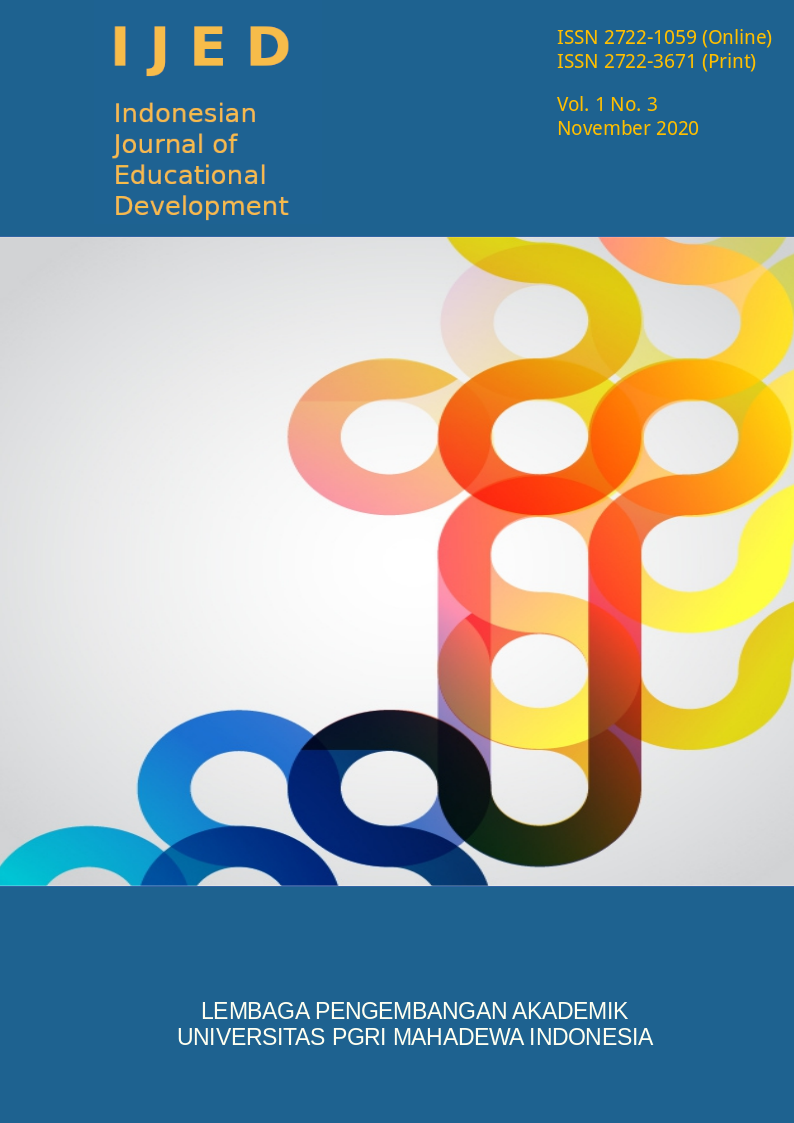Penerapan model pembinaan kelompok dan individu untuk meningkatkan nilai akreditasi komponen standar isi bagi sekolah binaan SMP wilayah kecamatan Pemalang
DOI:
https://doi.org/10.5281/zenodo.4287482Keywords:
accreditation, content standards, supervisionAbstract
This study aims to improve the ability of schools in making physical evidence of school accreditation of content standard components through group and individual models. The method used in this research is comparative descriptive. Data were collected using observation and documentation. The school that was used as a research location was SMP Pemalang District. The results showed that not all schools were able to make physical evidence of school accreditation standard components of the initial data content from the results of the self-evaluation of the coaching observations obtained a score of 2.0 (sufficient category) in cycle I reached an average of 2.81 (good category) there was an increase of 0 , 81, while in the second cycle it reached an average of 3.6 (very good category) there was an increase of 1.6. The results of supervision got an average score of 2.8 (good category) after coaching the group model reached an average of 3.0 (good category) there was an increase of 0.2, and in cycle II with an individual model it reached an average of 3, 9 (very good category) there is an increase of 1.1. From the results of this study, it can be suggested that schools carry out physical evidence preparation using group and individual models, as well as mobilizing teachers, school administrator, committees, and other stakeholders to prepare physical evidence of school accreditation, especially the content standard component.
Penelitian ini bertujuan untuk meningkatkan kemampuan sekolah dalam membuat bukti fisik akreditasi sekolah komponen standar isi melalui model kelompok dan individu. Metode yang digunakan dalam penelitian ini adalah deskriptif komparatif. Data dijaring dengan menggunakan observasi dan dokumentasi. Sekolah yang dijadikan tempat penelitian, yaitu SMP wilayah Kecamatan Pemalang. Hasil penelitian menunjukkan bahwa belum semua sekolah dapat membuat bukti fisik akreditasi sekolah komponen standar isi data awal dari hasil evaluasi diri pengamatan pembinaan memperoleh skor 2,0 (kategori cukup) pada siklus I mencapai rata–rata 2,81 (kategori baik) ada kenaikan 0,81, sedangkan pada siklus II mencapai rata–rata 3,6 (kategori amat baik) ada kenaikan 1,6. Hasil supervisi mendapatkan nilai dengan rata–rata 2,8 (kategori baik) setelah diadakan pembinaan model kelompok mencapai rata–rata 3,0 (kategori baik) ada kenaikan 0,2, dan pada siklus II dengan model individu mencapai rata–rata 3,9 (kategori amat baik) ada kenaikan 1,1. Dari hasil penelitian tersebut dapat disarankan agar sekolah melaksanakan penyiapan bukti fisik dengan model kelompok dan individu, serta menggerakan guru, penjaga, komite, dan stakeholder yang lain untuk menyiapkan bukti fisik akreditasi sekolah, khususnya komponen standar isi.
Downloads
References
Anaroga, P. (2001). Psikologi Kerja. Rineka Cipta.
Arikunto, S. (1993). Manajemen Pengajaran Secara Manusiawi. Rineka Cipta.
Badafal, I. (2003). Manajemen Peningkatan Mutu SMP. Bumi Aksara.
Badan Akreditasi Nasional Sekolah/ Madrasah (BAN-SM). (2016). Pedoman Akreditasi Sekolah/ Madrasah 2016. Badan Akreditasi Nasional Sekolah/ Madrasah (BAN-SM).
Keputusan Menpan Nomor 91/KEP/M.PAN/10/2001 tentang Jabatan Fungsional Pengawas Sekolah dan Angka Kreditnya.
Mulyasa, E. (2007). Menjadi Guru Profesional. Remaja Rosdakarya.
Mulyasa, E. (2007). Menjadi Kepala Sekolah Profesional. Remaja Rosdakarya.
Raharjo, S. & Gudnanto. (2011). Pemahaman Individu Teknik Non Tes. Nora Media Enterprise
Rahayu, I. T. (2004). Observasi dan Wawancara. Bayu Media Publishing.
Ruky, A. S. (2001). Sistem Manajemen Kinerja. Gramedia Pustaka Utama.
Stoner, J. A. F. & Wankel, C. (1986). Manajemen. Intermedia.
Sugiyono. 2009. Metode Penelitian Pendidikan Kuantitatif, Kualitatif, dan R & D. Albeta.
Undang–Undang Nomor 20 Tahun 2003 tentang Sistem Pendidikan Nasional.
Downloads
Published
How to Cite
Issue
Section
License
Copyright (c) 2020 Trini Winarti

This work is licensed under a Creative Commons Attribution 4.0 International License.
This is an Open Access article distributed under the terms of Creative Commons Attribution 4.0 International License, which permits use, sharing, adaptation, distribution and reproduction in any medium or format, as long as you give appropriate credit to the original author(s) and the source, provide a link to the Creative Commons licence, and indicate if changes were made. The images or other third party material in this article are included in the article's Creative Commons licence, unless indicated otherwise in a credit line to the material.

















